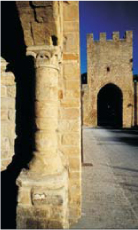San Ginesio is a medieval castle and also its horizon. The golden yellow of its sandstone, that makes up the houses, towers, walls, palaces, drew his sense from the blue of Sibillini mountains. Born in the highest part of the hill Esulano, between X and XI century, San Ginesio immediately imposes its strong identity, its past power and greatness.
The first image of the village, which is like a fire brand, is that of a gate, Porta Picena, which with its majestic arch interrupts the running of the castle walls, still impressive and undamaged. The building of the walls started in 1308: they would have defended San Ginesio from the ambitions of neighboring peoples. It took 150 years to accomplish the work: a bailey all around the castle with eight gates, four of which (Alvaneto, Ascarana, Offuna and Picena) still intact. Porta Picena delivery to the eye another glimpse of history: the Hospital of the pilgrims (or of San Paolo – late XIII century), a “domus hospitalis” which gave shelter to pilgrims on the way to Rome or Loreto.
Going back streets and alleys, to the central square, history and art mingle.
The second image is the facade of the most important church, the Collegiata (1098), and, in the foreground, the profile of the statue of Alberico Gentili (San Ginesio 1552-London 1608), great jurist, humanist intellectual, father of the International Law. The facade has a Romanesque base topped by a stone “altarpiece” (the only example of flamboyant Gothic in Marche, made in 1421 by Enrico Alemanno).
Moving eyes around, you can see the Theater “Giacomo Leopardi”, once occupied by the Defensorale Palace. A jewel of XIX century, which shines a more dating light: in 1547 a wooden amphitheater dominated the square and drew spectators from many countries around. The same San Ginesio, indeed, is the patron of mimes and actors. Behind the Collegiata there is the Pinacoteca “Scipione Gentili”, with pictures by Simone De Magistris, Vincenzo Pagani, a “Marriage of St. Catherine” attributed to Ghirlandaio, and altar piece of Sant’Andrea (also named “The battle between Ginesini and Fermani”, reminiscent the fight of November 30, 1377).
Then the church of San Francesco (1050), the historical site of the popular assemblies, with a cycle of frescoes of the ‘300 (school of Giotto), and yet the complex of Sts. Thomas and Barnabas (1365), directly dependent on the Vatican, which once belonged to the Confraternity of the Flagellants or Disciplined: its history is carved on stone corbels of the portal, where you read the symbols of the Passion. The ideal circle closes with the convent and the church of the Augustinians, now the seat of the auditorium hall. Inside, where in the thirteenth century walked St. Nicholas of Tolentino, houses one of the oldest organ in Europe (1530).
This road on the trail of culture reserves a thousand placet and other masterpieces. You can choose to follow them or you can walk on instinct. Frequently, down the streets or in the middle of the houses, a natural balcony discover a magnificent panorama. A chain of mountains from the Gran Sasso to the Adriatic to the tips of the Conero over an expanse of hills and villages and perfect fields. The third picture, where you can be shipwrecked.

